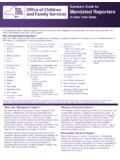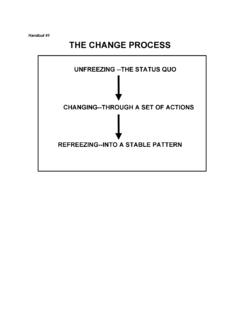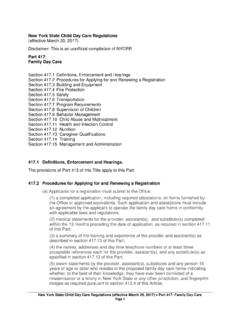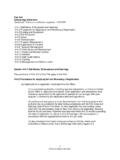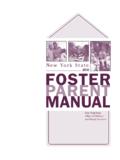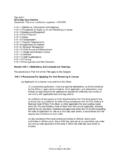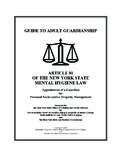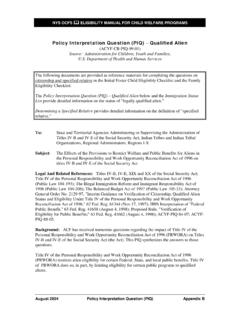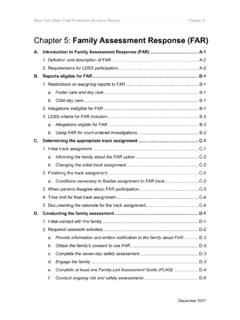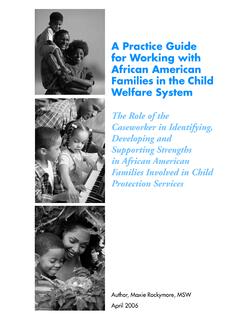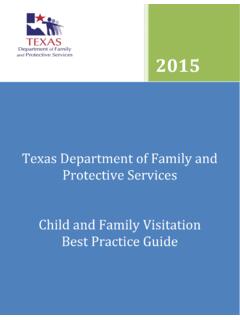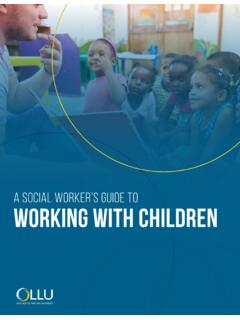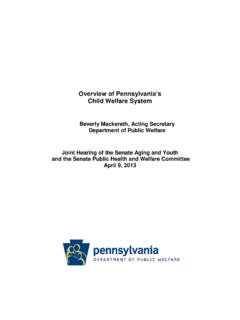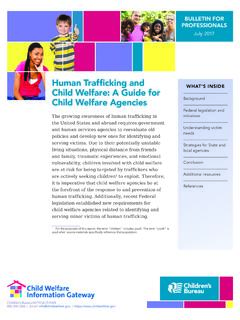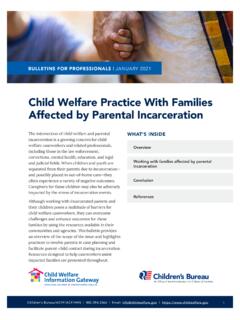Transcription of Module 5: Safety Assessment - New York State Office of ...
1 Edited: 1/2017 5-1 Module 5: Safety Assessment Table of Contents Introduction and Rationale ..5-2 Which Safety Assessment Is Completed? ..5-2 CPS-Protective Safety Assessment ..5-3 Completing a CPS-Protective Safety Assessment ..5-3 Determining the Focus of the CPS-Protective Safety Assessment ..5-4 Documenting the Safety Assessment ..5-5 Continuing to Reassess and Document Safety ..5-5 Completing the Safety Assessment Window ..5-6 Safety Assessment Window: Safety Factors Tab ..5-7 Safety Assessment Window: Safety Decision Tab .. 5-11 Safety Assessment Window: Parent/Caretaker Actions/ Safety Plan Tab .. 5-15 Safety Assessment Window: Controlling Interventions/ Safety Plan Tab .. 5-18 The Non-CPS Safety Assessment .. 5-21 Completing a Non-CPS Safety Assessment ? .. 5-21 Determining the Focus of the Safety Assessment .. 5-21 Documenting the Safety Assessment .. 5-22 Continuing to Reassess and Document Safety .. 5-23 Safety Assessment (Non-Protective) Window.
2 5-24 Completing the Safety Assessment (Non-Protective) Window .. 5-24 Frequently Asked Questions .. 5-26 Appendix .. 5-27 5A: Safety Factor Checklist .. 5-27 5B: Expanded Safety Factors .. 5-29 5C: Controlling Interventions Checklist .. 5-35 5D: Non-CPS Safety Issues and Concerns .. 5-36 Edited: 1/2017 5-2 Introduction and Rationale Promoting and supporting Safety is a fundamental child welfare function performed throughout the life of a case. This Module assists caseworkers in accurately documenting their Assessment of Safety within the FASP. It will also help FASP approvers to appropriately approve FASPs and provide effective feedback to FASP authors. Which Safety Assessment Is Completed? There are two distinct formats for Safety Assessments in the FASP: CPS-Protective Safety Assessment Non-CPS Safety Assessment The primary focus of the CPS-Protective Safety Assessment is on the parent s/caretaker s actions or inactions and the dangers their behaviors may pose to one or more children within the family.
3 In a Non-CPS Safety Assessment , the focus is on behaviors and circumstances within the family, other than the parent s/caretaker s actions or inactions, which may affect the Safety of the child, family, or community. This often involves a child s behavior that endangers him/her or others. For examples of both CPS-Protective and Non-CPS Safety Issues, see Appendix 5A: Safety Factor Checklist and Appendix 5D: Non-CPS Safety Issues and Concerns. CONNECTIONS will automatically generate the appropriate Safety Assessment for the caseworker to complete, based upon the Program Choices selected for the children in a given case. A CPS-Protective Safety Assessment will be generated when children in the FSS have a Program Choice of Protective. The CPS-Protective Safety Assessment will continue to be generated within each FASP as long as the Program Choice of Protective remains effective. For CPS-Protective cases in which one or more non-CPS Safety concerns also exist, these concerns can and should be documented within the CPS-Protective Safety Assessment .
4 When the Program Choice of Protective is not selected, a Non-CPS Safety Assessment will be generated for the caseworker to complete. It is critical that the correct Program Choices be selected in every case, and that the accuracy of the Program Choices is affirmed each time a FASP is launched. Inaccurate Program Choices will result in the wrong Safety Assessment being generated and completed. Consistency Check Before launching a FASP, be sure that the Program Choices for each child are accurate. This will ensure that CONNECTIONS customizes the FASP with the correct content and format for the Safety Assessment . For more information about selecting Program Choices, see Module 3: Stage Composition and Tracked Children Detail. Edited: 1/2017 5-3 CPS-Protective Safety Assessment Promoting and supporting Safety is the paramount focus of Child Welfare services. A child is safe ( , does not need protection at this time) when there is no immediate or impending danger of serious harm to the child s life or health as a result of acts of commission or omission (actions or inactions) by the child s parents and/or caretakers.
5 The purpose of the CPS-Protective Safety Assessment is to guide caseworkers Assessment of factors in the children s family/home that may place a child in immediate or impending danger of serious harm, and to determine what actions/interventions, if any, need to be put in place or maintained to protect the children. The CPS-Protective Safety Assessment is designed to guide caseworkers through a thorough, balanced, and structured process to: Identify any Safety Factors that are present Determine whether alone or in combination, any of the identified factors place children in immediate or impending danger of serious harm Decide what action, if any, is necessary to protect children from the identified danger Develop, implement, and monitor a Safety Plan, when needed, to protect the children from the danger Accuracy Check To generate a CPS-Protective Safety Assessment , children in a case must have a Program Choice of Protective.
6 Before launching a FASP, be sure that the Program Choice for each child is accurate. This will ensure that CONNECTIONS customizes the FASP with the correct Safety Assessment . Completing a CPS-Protective Safety Assessment The Safety Assessment process begins with the family s first contact with the Child Welfare system and continues throughout the life of a case. Caseworkers continually need to be alert to changes in the level of Safety within a family, as new and emerging threats can occur. Safety Assessments are conducted through direct observations of the family and interviews with caretakers and children, collaterals, and other service providers who know the family. Caseworkers are expected to document key observations regarding Safety in their ongoing progress notes, and to document a more structured Assessment of Safety at key junctures throughout the case. In CPS cases, a Safety Assessment must be documented: Within seven days of the receipt of an SCR report At the conclusion of the CPS investigation On each FASP When a child s Safety status or plan changes Upon a child s discharge from foster care Edited: 1/2017 5-4 At case closure Determining the Focus of the CPS-Protective Safety Assessment The focus of the Safety Assessment in a Child Welfare Services case is always the children s family/home of origin.
7 The purpose of the Safety Assessment is to determine if it is necessary to take actions (or to continue or change actions already taken) to support the Safety of the children within their own home. When children are in foster care (or in another temporary alternative living arrangement), the focus of subsequent Safety Assessments continues to be on the children s family/home of origin; the caseworker s task is to reexamine circumstances in the children s home of origin to determine if the Safety Plan is still necessary, appropriate, and effective given current circumstances in the home of origin, or if adjustments to the plan are needed to effectively support Safety based on changes within the home of origin ( , Given current circumstances at home, do the children still need to be in foster care? Are there other alternative interventions that could adequately address Safety ? Has the family s capacity to protect changed? Does the Safety Plan need to be changed due to changes within the home of origin?)
8 Helpful Tip Before completing the Safety Assessment , it is essential that the caseworker accurately determine the appropriate household or households to assess, including an accurate accounting of all adults and children within that household. In addition to parents and their children, households may include a parent s partner living in or frequenting the home, extended family, or others who impact Safety within the home. All persons living in or frequenting the home need to be accounted for when assessing Safety . In complex households, it can be helpful to construct a simple genogram, or family map, to help the caseworker accurately determine household composition and the focus of the Assessment . Redundancy Prevention Tip There is an opportunity within the Foster Care (FC) Issues section of the FASP to also look at Safety within the foster care setting or alternative living arrangement. Safety within the foster care setting or an alternative living arrangement should be addressed in the FC Issues section, not in the CPS-Protective Safety Assessment .
9 Edited: 1/2017 5-5 Documenting the Safety Assessment All caseworkers are expected to assess Safety in their ongoing contacts with families and children, and to take whatever actions are necessary in response to emerging Safety threats. They should also document relevant observations, changes, and actions on the Progress Notes tab. The Safety Plan, or a need for one, is continually reassessed during each contact with the family. Changes to the Safety Plan must be put in place immediately to support Safety , and not be deferred until the next FASP. It is the Case Planner who is ultimately responsible for documenting the Safety Assessment within the FASP, although in some districts this responsibility is assigned to the CPS Worker/Monitor. The documented Safety Assessment , including the Safety Plan, should represent the shared findings and decisions of the team working with the family. While Safety is reassessed on an ongoing basis, some good opportunities for determining or reaffirming the team s observations and consensus regarding Safety include, but are not limited to, the Safety conference following a child s placement, the Service Plan Review Conference, court proceedings, and any team/family conferences regarding next steps in the case.
10 Continuing to Reassess and Document Safety Changing family circumstances affect Safety over time. Children could quickly become endangered due to change in family circumstances. In order to determine the need for a Safety Plan, the caseworker must review the children s family/home of origin during every contact to get an accurate, current understanding of family circumstances. Throughout the case, caseworkers need to identify any changes affecting Safety that may have occurred, and to adjust the Safety Decision and Safety Plan accordingly. Actions taken to protect children must be sufficient to offset the Safety Factors that place children in immediate or impending danger of serious harm; Safety Plans also need to be adjusted given positive or negative changes in the family situation. Safety Plans should effectively and appropriately utilize the family s resources whenever possible, as they become known or change over time. Examples of changes in children/family circumstances that may prompt changes to a Safety Plan: Children s needs change ( , the child s medical/mental health status worsens to a point where the child s life/health is jeopardized and the parent(s) are unable to effectively respond to the child s needs; the child s medical condition subsides) A dangerous condition in the home is corrected ( , heat is re-established in the apartment) A parent stops, or becomes inconsistent in maintaining the behaviors or actions they agreed to as part of their contribution to the Safety Plan ( , the parent stops taking the child to a clinic when the child is sick.)
